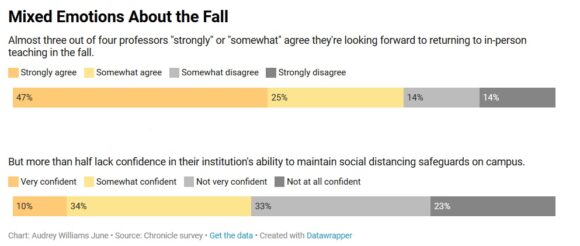Dear Commons Community,
This past March, faculty at colleges and universities around the country scrambled to move courses online because of the coronavirus pandemic. The Chronicle of Higher Education conducted a survey (N=1,530) of faculty and administrators, here is a summary as reported.
“This spring brought change on an unprecedented scale, as colleges of all types shifted to remote instruction. The abrupt pivot left institutions scrambling to provide continuity of learning, as faculty members grappled with the intricacies of learning-management systems, unfamiliar conferencing technologies, and new protocols for coursework and tests — often with scant instructional-support infrastructure.
A Chronicle survey reveals just what faculty members and academic administrators think about their emergency efforts. They agree on one key metric: About 60 percent of faculty members, and a similar share of academic administrators, said spring’s courses were worse than face-to-face offerings.
“I need a lot more experience/training to do it again,” said one respondent when asked about the most important lesson learned from teaching this spring.
The Chronicle’s survey was conducted for “Online 2.0: Managing a Large-Scale Move to Online Learning,” a new special report that explores how institutions can take remote learning to the next level. Read more by purchasing a copy here.
The survey of faculty members and academic administrators from two- and four-year institutions was conducted online from May 11 to May 17. Responses came from 935 faculty members, ranging from full professor to adjunct, and from 595 academic administrators, whose job titles included provost, dean, and department head, among others.
Their struggles during the spring semester were many. Nearly eight out of 10 instructors said “creating a sense of engagement between myself and my students” was “very” or “somewhat” challenging.
As colleges make decisions about how the 2020-21 academic year will proceed, faculty members reported that they are confident about teaching online in the fall — and ambivalent about returning to campus.
Given that faculty had to move to online teaching in a matter of days with little or no training or planning, the results are not to be expected. Also the fact that the majority of faculty and administrators commented that students lacked assess to technology or Wi-Fi is surprising.
Below are several key tables from the report.
Tony








